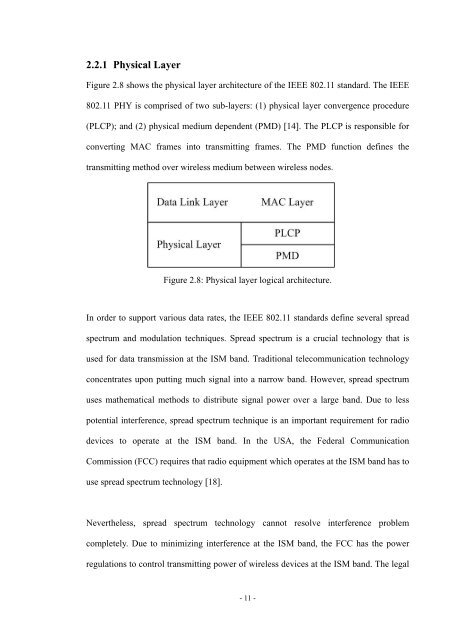An Investigation of the Impact of Signal Strength on Wi-Fi Link ...
An Investigation of the Impact of Signal Strength on Wi-Fi Link ...
An Investigation of the Impact of Signal Strength on Wi-Fi Link ...
You also want an ePaper? Increase the reach of your titles
YUMPU automatically turns print PDFs into web optimized ePapers that Google loves.
2.2.1 Physical Layer<br />
<strong>Fi</strong>gure 2.8 shows <str<strong>on</strong>g>the</str<strong>on</strong>g> physical layer architecture <str<strong>on</strong>g>of</str<strong>on</strong>g> <str<strong>on</strong>g>the</str<strong>on</strong>g> IEEE 802.11 standard. The IEEE<br />
802.11 PHY is comprised <str<strong>on</strong>g>of</str<strong>on</strong>g> two sub-layers: (1) physical layer c<strong>on</strong>vergence procedure<br />
(PLCP); and (2) physical medium dependent (PMD) [14]. The PLCP is resp<strong>on</strong>sible for<br />
c<strong>on</strong>verting MAC frames into transmitting frames. The PMD functi<strong>on</strong> defines <str<strong>on</strong>g>the</str<strong>on</strong>g><br />
transmitting method over wireless medium between wireless nodes.<br />
<strong>Fi</strong>gure 2.8: Physical layer logical architecture.<br />
In order to support various data rates, <str<strong>on</strong>g>the</str<strong>on</strong>g> IEEE 802.11 standards define several spread<br />
spectrum and modulati<strong>on</strong> techniques. Spread spectrum is a crucial technology that is<br />
used for data transmissi<strong>on</strong> at <str<strong>on</strong>g>the</str<strong>on</strong>g> ISM band. Traditi<strong>on</strong>al telecommunicati<strong>on</strong> technology<br />
c<strong>on</strong>centrates up<strong>on</strong> putting much signal into a narrow band. However, spread spectrum<br />
uses ma<str<strong>on</strong>g>the</str<strong>on</strong>g>matical methods to distribute signal power over a large band. Due to less<br />
potential interference, spread spectrum technique is an important requirement for radio<br />
devices to operate at <str<strong>on</strong>g>the</str<strong>on</strong>g> ISM band. In <str<strong>on</strong>g>the</str<strong>on</strong>g> USA, <str<strong>on</strong>g>the</str<strong>on</strong>g> Federal Communicati<strong>on</strong><br />
Commissi<strong>on</strong> (FCC) requires that radio equipment which operates at <str<strong>on</strong>g>the</str<strong>on</strong>g> ISM band has to<br />
use spread spectrum technology [18].<br />
Never<str<strong>on</strong>g>the</str<strong>on</strong>g>less, spread spectrum technology cannot resolve interference problem<br />
completely. Due to minimizing interference at <str<strong>on</strong>g>the</str<strong>on</strong>g> ISM band, <str<strong>on</strong>g>the</str<strong>on</strong>g> FCC has <str<strong>on</strong>g>the</str<strong>on</strong>g> power<br />
regulati<strong>on</strong>s to c<strong>on</strong>trol transmitting power <str<strong>on</strong>g>of</str<strong>on</strong>g> wireless devices at <str<strong>on</strong>g>the</str<strong>on</strong>g> ISM band. The legal<br />
- 11 -
















